Great Wall of China
Great Wall of China
From Wikipedia, the free encyclopedia
"Great Wall" redirects here. For other uses, see Great Wall (disambiguation).
| Great Wall of China | |
|---|---|
| 万里长城 | |
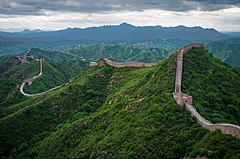
The Great Wall of China at Jinshanling
| |

Map of all the wall constructions
| |
| General information | |
| Type | Fortification |
| Country | |
| Coordinates | 40.67693°N 117.23193°ECoordinates: 40.67693°N 117.23193°E |
| Technical details | |
| Size | 21,196 km (13,171 mi)[1] |
| Official name | The Great Wall |
| Type | Cultural |
| Criteria | i, ii, iii, iv, vi |
| Designated | 1987 (11th session) |
| Reference no. | 438 |
| State Party | China |
| Region | Asia-Pacific |
| Great Wall of China | |||
| Traditional Chinese | 長城 | ||
|---|---|---|---|
| Simplified Chinese | 长城 | ||
| Literal meaning | "The Long Wall" | ||
| |||
| Alternative Chinese name | |||
| Traditional Chinese | 萬里長城 | ||
| Simplified Chinese | 万里长城 | ||
| Literal meaning | "The 10,000-Mile Long Wall" | ||
| |||
The Great Wall of China is a series of fortifications made of stone, brick, tamped earth, wood, and other materials, generally built along an east-to-west line across the historical northern borders of China to protect the Chinese states and empires against the raids and invasions of the various nomadic groups of the Eurasian Steppe. Several walls were being built as early as the 7th century bce;[2]these, later joined together and made bigger and stronger, are now collectively referred to as the Great Wall.[3] Especially famous is the wall built 220–206 bce by Qin Shi Huang, the first Emperor of China. Little of that wall remains. Since then, the Great Wall has on and off been rebuilt, maintained, and enhanced; the majority of the existing wall is from the Ming Dynasty.
Other purposes of the Great Wall have included border controls, allowing the imposition of duties on goods transported along the Silk Road, regulation or encouragement of trade and the control of immigration and emigration. Furthermore, the defensive characteristics of the Great Wall were enhanced by the construction of watch towers, troop barracks, garrison stations, signaling capabilities through the means of smoke or fire, and the fact that the path of the Great Wall also served as a transportation corridor.
The Great Wall stretches from Dandong in the east, to Lop Lake in the west, along an arc that roughly delineates the southern edge of Inner Mongolia. A comprehensive archaeological survey, using advanced technologies, has concluded that the Ming walls measure 8,850 km (5,500 mi).[4] This is made up of 6,259 km (3,889 mi) sections of actual wall, 359 km (223 mi) of trenches and 2,232 km (1,387 mi) of natural defensive barriers such as hills and rivers.[4] Another archaeological survey found that the entire wall with all of its branches measure out to be 21,196 km (13,171 mi).[5]
Contents
[hide]Names
The collection of fortifications now known as "The Great Wall of China" has historically had a number of different names in both Chinese and English.
In Chinese histories, the term "Long Wall(s)" (長城, changcheng) appears in Sima Qian's Records of the Grand Historian, where it referred to both the separate great walls built between and north of the Warring States and to the more unified construction of theFirst Emperor.[6] The Chinese character 城 is a phono-semantic compound of the "place" or "earth" radical 土 and 成, whose Old Chinese pronunciation has been reconstructed as *deŋ.[7] It originally referred to the rampart which surrounded traditional Chinese cities and was used by extension for these walls around their respective states; today, however, it is much more often simply the Chinese word for "city".[8]
The longer Chinese name "Ten-Thousand-Mile Long Wall" (萬里長城, Wanli Changcheng) came from Sima Qian's description of it in the Records, though he did not name the walls as such. The ad 493 Book of Song quotes the frontier general Tan Daoji referring to "the long wall of 10,000 miles", closer to the modern name, but the name rarely features in pre-modern times otherwise.[9] Thetraditional Chinese mile (里, lǐ) was an often irregular distance that was intended to show the length of a standard village and varied with terrain but was usually standardized at distances around a third of an English mile.[10] Since China's metrication in 1930, it has been exactly equivalent to (500 metres or 1,600 feet),[11] which would make the wall's name describe a distance of 5,000 kilometres (3,100 mi). However, this use of "ten-thousand" (wàn) is figurative in a similar manner to the Greek and English myriad and simply means "innumerable" or "immeasurable".[12]
Because of the wall's association with the First Emperor's supposed tyranny, the Chinese dynasties after Qin usually avoided referring to their own additions to the wall by the name "Long Wall".[13] Instead, various terms were used in medieval records, including "frontier(s)" (塞, sāi),[14] "rampart(s)" (垣, yuán),[14] "barrier(s)" (障, zhàng),[14] "the outer fortresses" (外堡, wàibǎo),[15] and "the border wall(s)" (t 邊牆, s 边墙, biānqiáng).[13] Poetic and informal names for the wall included "the Purple Frontier" (紫塞, Zǐsāi)[16] and "the Earth Dragon" (t 土龍, s 土龙, Tǔlóng).[17] Only during the Qing period did "Long Wall" become the catch-all term to refer to the many border walls regardless of their location or dynastic origin, equivalent to the English "Great Wall".[18]
The current English name evolved from accounts of "the Chinese wall" from early modern European travelers.[18] By the 19th century,[18] "The Great Wall of China" had become standard in English, French, and German, although other European languages continued to refer to it as "the Chinese wall".[12]
History
Main article: History of the Great Wall of China
Early walls
The Chinese were already familiar with the techniques of wall-building by the time of the Spring and Autumn period between the 8th and 5th centuries bce.[19] During this time and the subsequent Warring States period, the states of Qin, Wei, Zhao, Qi, Yan, andZhongshan[20][21] all constructed extensive fortifications to defend their own borders. Built to withstand the attack of small arms such as swords and spears, these walls were made mostly by stamping earth and gravel between board frames.
King Zheng of Qin conquered the last of his opponents and unified China as the First Emperor of the Qin dynasty ("Qin Shi Huang") in 221 bce. Intending to impose centralized rule and prevent the resurgence of feudal lords, he ordered the destruction of the sections of the walls that divided his empire among the former states. To position the empire against the Xiongnu people from the north, however, he ordered the building of new walls to connect the remaining fortifications along the empire's northern frontier. Transporting the large quantity of materials required for construction was difficult, so builders always tried to use local resources. Stones from the mountains were used over mountain ranges, while rammed earth was used for construction in the plains. There are no surviving historical records indicating the exact length and course of the Qin walls. Most of the ancient walls have eroded away over the centuries, and very few sections remain today. The human cost of the construction is unknown, but it has been estimated by some authors that hundreds of thousands,[22] if not up to a million, workers died building the Qin wall.[23][24] Later, the Han,[25] the Sui, and the Northern dynasties all repaired, rebuilt, or expanded sections of the Great Wall at great cost to defend themselves against northern invaders.[26] The Tang andSong dynasties did not undertake any significant effort in the region.[26] The Liao, Jin, and Yuan dynasties, who ruled Northern China throughout most of the 10th–13th centuries, constructed defensive walls in the 12th century but those were located much to the north of the Great Wall as we know it, within China's province of Inner Mongolia and in Mongolia itself.[27]
Ming era
Main article: Ming Great Wall
The Great Wall concept was revived again under the Ming in the 14th century,[28] and following the Ming army's defeat by the Oirats in theBattle of Tumu. The Ming had failed to gain a clear upper hand over the Mongolian tribes after successive battles, and the long-drawn conflict was taking a toll on the empire. The Ming adopted a new strategy to keep the nomadic tribes out by constructing walls along the northern border of China. Acknowledging the Mongol control established in the Ordos Desert, the wall followed the desert's southern edge instead of incorporating the bend of the Yellow River.
Unlike the earlier fortifications, the Ming construction was stronger and more elaborate due to the use of bricks and stone instead of rammed earth. Up to 25,000 watchtowers are estimated to have been constructed on the wall.[29] As Mongol raids continued periodically over the years, the Ming devoted considerable resources to repair and reinforce the walls. Sections near the Ming capital of Beijing were especially strong.[30] Qi Jiguang between 1567 and 1570 also repaired and reinforced the wall, faced sections of the ram-earth wall with bricks and constructed 1,200 watchtowers from Shanhaiguan Pass to Changping to warn of approaching Mongol raiders.[31] During the 1440s–1460s, the Ming also built a so-called "Liaodong Wall". Similar in function to the Great Wall (whose extension, in a sense, it was), but more basic in construction, the Liaodong Wall enclosed the agricultural heartland of the Liaodong province, protecting it against potential incursions by Jurched-Mongol Oriyanghan from the northwest and theJianzhou Jurchens from the north. While stones and tiles were used in some parts of the Liaodong Wall, most of it was in fact simply an earth dike with moats on both sides.[32]
Towards the end of the Ming, the Great Wall helped defend the empire against the Manchu invasions that began around 1600. Even after the loss of all of Liaodong, the Ming army held the heavily fortified Shanhai Pass, preventing the Manchus from conquering the Chinese heartland. The Manchus were finally able to cross the Great Wall in 1644, after Beijing had already fallen to Li Zicheng's rebels. Before this time, the Manchus had crossed the Great Wall multiple times to raid, but this time it was for conquest. The gates at Shanhai Pass were opened on May 25 by the commanding Ming general, Wu Sangui, who formed an alliance with the Manchus, hoping to use the Manchus to expel the rebels from Beijing.[33] The Manchus quickly seized Beijing, and eventually defeated both the rebel-founded Shun dynasty and the remaining Ming resistance, establishing theQing dynasty rule over all of China.[34]
Under Qing rule, China's borders extended beyond the walls and Mongolia was annexed into the empire, so constructions on the Great Wall were discontinued. On the other hand, the so-called Willow Palisade, following a line similar to that of the Ming Liaodong Wall, was constructed by the Qing rulers in Manchuria. Its purpose, however, was not defense but rather migration control.
Foreign accounts of the Wall
None of the Europeans in Medieval China, such as Marco Polo, Giovanni da Pian del Carpine, and William of Rubruck, mentioned the Great Wall.[35]
The North African traveler Ibn Battuta heard about China's Great Wall—which he estimated at "sixty days' travel" from Zeitun (modernQuanzhou)—from local Muslim communities in Guangzhou around 1346 and spread its reputation west in his Gift to Those Who Contemplate the Wonders of Cities and the Marvels of Travelling. He associated it with the legend of the wall mentioned in the Qur'an[36]which Dhul-Qarnayn (commonly associated with Alexander the Great) was said to have erected to protect people near the land of the rising sun from the savages of Gog and Magog.[37]
Soon after Europeans reached Ming China by ship in the early 16th century, accounts of the Great Wall started to circulate in Europe, even though no European was to see it with his own eyes for another century. Possibly one of the earliest descriptions of the wall and of its significance for the defense of the country against the "Tartars" (i.e. Mongols), may be the one contained in João de Barros's 1563Asia.[38] Other early accounts in Western sources include those of Gaspar da Cruz, Bento de Goes, Matteo Ricci, and Bishop Juan González de Mendoza.[39] In 1559, in his work "A Treatise of China and the Adjoyning Regions," Gaspar da Cruz offers an early discussion of the Great Wall.[39] Perhaps the first recorded instance of a European actually entering China via the Great Wall came in 1605, when the Portuguese Jesuit brother Bento de Góis reached the northwestern Jiayu Pass from India.[40] Early European accounts were mostly modest and empirical, closely mirroring contemporary Chinese understanding of the Wall,[41] although later they slid into hyperbole,[42] including the erroneous but ubiquitous claim that the Ming Walls were the same ones that were built by the First Emperor in the 3rd century bce.[42]
When China opened its borders to foreign merchants and visitors after its defeat in the First and Second Opium Wars, the Great Wall became a main attraction for tourists. The travelogues of the later 19th century further enhanced the reputation and the mythology of the Great Wall,[43] such that in the 20th century, a persistent misconception exists about the Great Wall of China being visible from the Moon or even Mars.[44]
Course
Although a formal definition of what constitutes a "Great Wall" has not been agreed upon, making the full course of the Great Wall difficult to describe in its entirety,[45] the course of the main Great Wall line following Ming constructions can be charted.
The Jiayu Pass, located in Gansu province, is the western terminus of the Ming Great Wall. Although Han fortifications such as Yumen Pass and the Yang Pass exist further west, the extant walls leading to those passes are difficult to trace. From Jiayu Pass the wall travels discontinuously down the Gansu Corridor and into the deserts of Ningxia, where it enters the western edge of the Yellow River loop atYinchuan. Here the first major walls erected during the Ming dynasty cuts through the Ordos Desert to the eastern edge of the Yellow River loop. There at Piantou Pass (t 偏頭關, s 偏头关, Piāntóuguān) in Xinzhou, Shanxi province, the Great Wall splits in two with the "Outer Great Wall" (t 外長城, s 外长城, Wài Chǎngchéng) extending along the Inner Mongolia border with Shanxi into Hebei province, and the "inner Great Wall" (t 內長城, s 內长城, Nèi Chǎngchéng) running southeast from Piantou Pass for some 400 kilometers (250 mi), passing through important passes like the Pingxing Pass and Yanmen Pass before joining the Outer Great Wall at Sihaiye(四海冶, Sìhǎiyě), in Beijing's Yanqing County.
The sections of the Great Wall around Beijing municipality are especially famous: they were frequently renovated and are regularly visited by tourists today. The Badaling Great Wall near Zhangjiakou is the most famous stretch of the Wall, for this is the first section to be opened to the public in the People's Republic of China, as well as the showpiece stretch for foreign dignitaries.[46] South of Badaling is theJuyong Pass; when used by the Chinese to protect their land, this section of the wall had many guards to defend China’s capital Beijing. Made of stone and bricks from the hills, this portion of the Great Wall is 7.8 meters (26 ft) high and 5 meters (16 ft) wide.
One of the most striking sections of the Ming Great Wall is where it climbs extremely steep slopes in Jinshanling. There it runs 11 kilometers (6.8 mi) long, ranges from 5 to 8 meters (16 to 26 ft) in height, and 6 meters (20 ft) across the bottom, narrowing up to 5 meters (16 ft) across the top. Wangjinglou (t 望京樓, s 望京楼, Wàngjīng Lóu) is one of Jinshanling's 67 watchtowers, 980 meters (3,220 ft) above sea level. Southeast of Jinshanling is the Mutianyu Great Wall which winds along lofty, cragged mountains from the southeast to the northwest for approximately 2.25 kilometers (about 1.3 miles). It is connected with Juyongguan Pass to the west and Gubeikou to the east. This section was one of the first to be renovated following the turmoil of the Cultural Revolution.[47]
At the edge of the Bohai Gulf is Shanhai Pass, considered the traditional end of the Great Wall and the "First Pass Under Heaven". The part of the wall inside Shanhai Pass that meets the sea is named the "Old Dragon Head". 3 kilometers (1.9 mi) north of Shanhai Pass is Jiaoshan Great Wall (焦山長城), the site of the first mountain of the Great Wall.[48]15 kilometers (9.3 mi) northeast from Shanhaiguan is Jiumenkou (t 九門口, s 九门口, Jiǔménkǒu), which is the only portion of the wall that was built as a bridge. Beyond Jiumenkou, an offshoot known as the Liaodong Wall continues through Liaoning province and terminates at the Hushan Great Wall, in the city of Dandong near the North Korean border.[49]
In 2009, 180 km of previously unknown sections of the wall concealed by hills, trenches and rivers were discovered with the help of infrared range finders and GPS devices.[50] In March and April 2015 nine sections with a total length of more than 10 km (6.2 mi), believed to be part of the Great Wall, were discovered along the border of Ningxiaautonomous region and Gansu province.[51]
Characteristics
Before the use of bricks, the Great Wall was mainly built from rammed earth, stones, and wood. During the Ming, however, bricks were heavily used in many areas of the wall, as were materials such as tiles, lime, and stone. The size and weight of the bricks made them easier to work with than earth and stone, so construction quickened. Additionally, bricks could bear more weight and endure better than rammed earth. Stone can hold under its own weight better than brick, but is more difficult to use. Consequently, stones cut in rectangular shapes were used for the foundation, inner and outer brims, and gateways of the wall. Battlements line the uppermost portion of the vast majority of the wall, with defensive gaps a little over 30 cm (12 in) tall, and about 23 cm (9.1 in) wide. From the parapets, guards could survey the surrounding land.[52] Communication between the army units along the length of the Great Wall, including the ability to call reinforcements and warn garrisons of enemy movements, was of high importance. Signal towers were built upon hill tops or other high points along the wall for their visibility. Wooden gates could be used as a trap against those going through. Barracks, stables, and armories were built near the wall's inner surface.[52]
Condition
While some portions north of Beijing and near tourist centers have been preserved and even extensively renovated, in many locations the Wall is in disrepair. Those parts might serve as a village playground or a source of stones to rebuild houses and roads.[53] Sections of the Wall are also prone to graffiti and vandalism, while inscribed bricks were pilfered and sold on the market for up to 50 renminbi.[54] Parts have been destroyed because the Wall is in the way of construction.[55] A 2012 report by the State Administration of Cultural Heritagestates that 22% of the Ming Great Wall has disappeared, while 1,961 kilometres (1,219 mi) of wall have vanished.[54] More than 60 km (37 mi) of the wall in Gansu province may disappear in the next 20 years, due to erosion from sandstorms. In places, the height of the wall has been reduced from more than 5 metres (16 feet) to less than 2 metres (6.6 ft). Various square lookout towers that characterize the most famous images of the wall have disappeared. Many western sections of the wall are constructed from mud, rather than brick and stone, and thus are more susceptible to erosion.[56]
Visibility from space
From the Moon
One of the earliest known references to this myth appears in a letter written in 1754 by the English antiquary William Stukeley. Stukeley wrote that, "This mighty wall of four score miles in length (Hadrian's Wall) is only exceeded by the Chinese Wall, which makes a considerable figure upon the terrestrial globe, and may be discerned at the Moon."[57] The claim was also mentioned by Henry Norman in 1895 where he states "besides its age it enjoys the reputation of being the only work of human hands on the globe visible from the Moon."[58] The issue of "canals" on Mars was prominent in the late 19th century and may have led to the belief that long, thin objects were visible from space.[59] The claim that the Great Wall is visible also appears in 1932's Ripley's Believe It or Not! strip[60] and in Richard Halliburton's 1938 book Second Book of Marvels.
The claim the Great Wall is visible from space has been debunked many times,[61] but is still ingrained in popular culture.[62] The wall is a maximum 9.1 m (30 ft) wide, and is about the same color as the soil surrounding it. Based on the optics of resolving power (distance versus the width of the iris: a few millimeters for the human eye, meters for large telescopes) only an object of reasonable contrast to its surroundings which is 70 mi (110 km) or more in diameter (1 arc-minute) would be visible to the unaided eye from the Moon, whose average distance from Earth is 384,393 km (238,851 mi). The apparent width of the Great Wall from the Moon is the same as that of a human hair viewed from 3.2 kilometers (2 mi) away. To see the wall from the Moon would require spatial resolution 17,000 times better than normal (20/20) vision.[63]Unsurprisingly, no lunar astronaut has ever claimed to have seen the Great Wall from the Moon.
From low Earth orbit
A more controversial question is whether the Wall is visible from low Earth orbit (an altitude of as little as 160 kilometers (100 mi)). NASAclaims that it is barely visible, and only under nearly perfect conditions; it is no more conspicuous than many other man-made objects.[64]Other authors have argued that due to limitations of the optics of the eye and the spacing of photoreceptors on the retina, it is impossible to see the wall with the naked eye, even from low orbit, and would require visual acuity of 20/3 (7.7 times better than normal).[63]
Astronaut William Pogue thought he had seen it from Skylab but discovered he was actually looking at the Grand Canal of China near Beijing. He spotted the Great Wall with binoculars, but said that "it wasn't visible to the unaided eye." U.S. Senator Jake Garn claimed to be able to see the Great Wall with the naked eye from a space shuttle orbit in the early 1980s, but his claim has been disputed by several U.S. astronauts. Veteran U.S. astronaut Gene Cernan has stated: "At Earth orbit of 100 to 200 miles (160 to 320 km) high, the Great Wall of China is, indeed, visible to the naked eye." Ed Lu, Expedition 7 Science Officer aboard the International Space Station, adds that, "it's less visible than a lot of other objects. And you have to know where to look."
In 2001, Neil Armstrong stated about the view from Apollo 11: "I do not believe that, at least with my eyes, there would be any man-made object that I could see. I have not yet found somebody who has told me they've seen the Wall of China from Earth orbit. ...I've asked various people, particularly Shuttle guys, that have been many orbits around China in the daytime, and the ones I've talked to didn't see it."[65]
In October 2003, Chinese astronaut Yang Liwei stated that he had not been able to see the Great Wall of China. In response, theEuropean Space Agency (ESA) issued a press release reporting that from an orbit between 160 and 320 kilometers (99 and 199 mi), the Great Wall is visible to the naked eye. In an attempt to further clarify things, the ESA published a picture of a part of the “Great Wall” photographed from low orbit. However, in a press release a week later (no longer available in the ESA’s website), they acknowledged that the "Great Wall" in the picture was actually a river.[63]
Leroy Chiao, a Chinese-American astronaut, took a photograph from the International Space Station that shows the wall. It was so indistinct that the photographer was not certain he had actually captured it. Based on the photograph, the China Daily later reported that the Great Wall can be seen from 'space' with the naked eye, under favorable viewing conditions, if one knows exactly where to look.[66] However, the resolution of a camera can be much higher than the human visual system, and the optics much better, rendering photographic evidence irrelevant to the issue of whether it is visible to the naked eye.[63]
Gallery
See also
Notes
- ^ "China’s Great Wall Found To Measure More Than 20,000 Kilometers". Bloomberg. June 5, 2012. Retrieved June 6, 2012.
- ^ The New York Times with introduction by Sam Tanenhaus (2011). The New York Times Guide to Essential Knowledge: A Desk Reference for the Curious Mind. St. Martin's Press ofMacmillan Publishers. p. 1131.ISBN 978-0-312-64302-7.
Beginning as separate sections of fortification around the 7th century B.C.E and unified during the Qin Dynasty in the 3rd century B.C.E, this wall, built of earth and rubble with a facing of brick or stone, runs from east to west across China for over 4,000 miles.

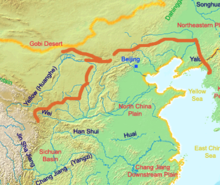

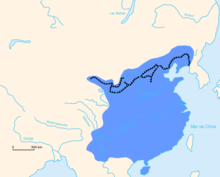
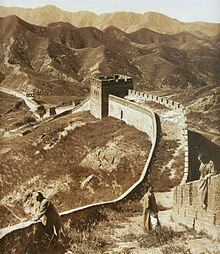

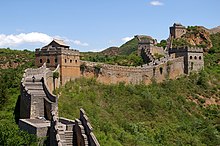
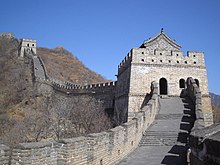
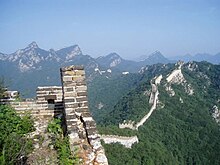





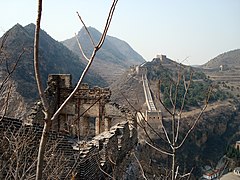




تعليقات
إرسال تعليق